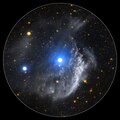Lêer:Extended Region Around the Planetary Nebula NGC 3242.tif

Size of this JPG preview of this TIF file: 600 × 600 piksels. Ander resolusies: 240 × 240 piksels | 480 × 480 piksels | 768 × 768 piksels | 1 024 × 1 024 piksels | 2 240 × 2 240 piksels.
Oorspronklike lêer (2 240 × 2 240 piksels, lêergrootte: 7,34 MG, MIME-tipe: image/tiff)
Lêergeskiedenis
Klik op die datum/tyd om te sien hoe die lêer destyds gelyk het.
| Datum/Tyd | Duimnael | Dimensies | Gebruiker | Opmerking | |
|---|---|---|---|---|---|
| huidig | 22:08, 30 Oktober 2013 |  | 2 240 × 2 240 (7,34 MG) | Stas1995 | User created page with UploadWizard |
Lêergebruik
Die volgende bladsy gebruik dié lêer:
Globale lêergebruik
Die volgende ander wiki's gebruik hierdie lêer:
- Gebruik in ar.wikipedia.org
- Gebruik in cs.wikipedia.org
- Gebruik in de.wikipedia.org
- Gebruik in el.wikipedia.org
- Gebruik in en.wikipedia.org
- Gebruik in fr.wikipedia.org
- Gebruik in lb.wikipedia.org
- Gebruik in sv.wikipedia.org
- Gebruik in vi.wikipedia.org
- Gebruik in zh.wikipedia.org

